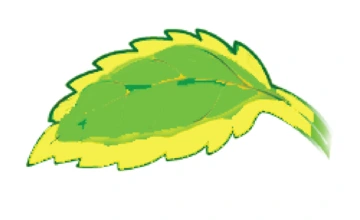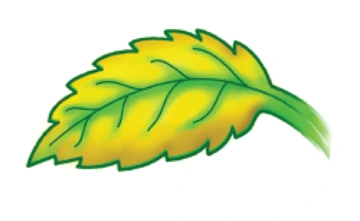Plants need the right combination of nutrients to live, grow and reproduce. When plants suffer from malnutrition, they show symptoms of being unhealthy. Too little or too much of any one nutrient can cause problems.
Plant nutrients fall into 2 categories: macronutrients and micronutrients. Macronutrients are those elements that are needed in relatively large amounts. They include nitrogen, potassium, sulfur, calcium, magnesium and phosphorus. Micronutrients are those elements that plants need in small amounts (sometimes trace amounts), like iron, boron, manganese, zinc, copper, chlorine and molybdenum. Both macro- and micronutrients are naturally obtained by the roots from the soil.
Plant roots require certain conditions to obtain these nutrients from the soil. First, the soil must be sufficiently moist to allow the roots to take up and transport the nutrients. Sometimes correcting improper watering strategies will eliminate nutrient deficiency symptoms. Second, the pH of the soil must be within a certain range for nutrients to be release-able from the soil particles. Third, the temperature of the soil must fall within a certain range for nutrient uptake to occur. The optimum range of temperature, pH and moisture is different for different species of plants. Thus, nutrients may be physically present in the soil, but not available to plants. A knowledge of soil pH, texture, and history can be very useful for predicting what nutrients may become deficient
Nitrogen, phosphorous, and iron are the only nutrients that are commonly lacking in Arizona soils. Most of the others can be lacking under certain conditions, but deficiencies are quite rare. The following table lists nutrients that may be lacking in Arizona soils, and what deficiency symptoms often look like. Keep in mind that each plant variety is different and may display different symptoms.
- Many nutrient deficiencies may look similar.
- It is important to know what a plant species looks like when it is healthy in order to recognize symptoms of distress, for example some plants were bred to have variegated patterns in the leaves when they are healthy.
- Many micronutrients are used by plants to process other nutrients or work together with other nutrients, so a deficiency of one may look like another (for instance, molybdenum is required by legumes to complete the nitrogen fixation process).
- If more than one problem is present, i.e. if water stress, disease, or insect pressure occurs simultaneously with a nutrient deficiency, or if two nutrients are deficient simultaneously, the typical symptoms may not occur.
Too much of any nutrient can be toxic to plants. This is most frequently evidenced by salt burn symptoms. These symptoms include marginal browning of leaves, separated from green leaf tissue by a slender yellow halo. The browning pattern, also called necrosis, begins at the tip and proceeds to the base of the leaf along the edge of the leaf.
Jump To:
Macronutrients
Replace macronutrients in soils at least once per growing season.
Calcium (Ca)
Desert soils and water generally have plenty f calcium, so deficiency problems are rare. Excessive calcium can limit the availability of other nutrients.
- Symptoms: New leaves (top of plant) are distorted or irregularly shaped. Causes blossom-end rot.
- Fertilizer source: Gypsum and also anything with the word "calcium."
Nitrogen (N)
Most plants absorb nitrogen in the form of ammonium or nitrate. These forms readily dissolve in water and leach away.
- Symptoms: General yellowing of older leaves (bottom of plant). The rest of the plant is often light green.
- Fertilizer source: Anything with the words “ammonium,” “nitrate,” or “urea.” Also manures.
Magnesium (Mg)
Plants absorb magnesium as an ion (charged particle), which can be readily leached from soil. May be readily leached from soil if calcium is not present.
- Symptoms: Older leaves turn yellow at edge leaving a green arrowhead shape in the center of the leaf.
- Fertilizer source: Anything with the word “magnesium”; also Epsom salts (magnesium sulfate).
Phosphorus (P)
Plants absorb phosphorus in the form of phosphate. This form dissolves only slightly in water, but pH strongly affects uptake.
- Symptoms: Leaf tips look burnt, followed by older leaves turning a dark green or reddish-purple.
- Fertilizer source: Anything with the words “phosphate” or “bone.” Also greensand.
Potassium (K)
Plants absorb potassium as an ion, which can be readily leached from soil. Desert soils and water generally have plenty of potassium, so deficiency problems are rare.
- Symptoms: Older leaves may wilt, look scorched. Interveinal chlorosis begins at the base, scorching inward from leaf margins.
- Fertilizer source: Anything with the words “potassium” or “potash.”
Sulfur (S)
Plants absorb sulfur in the form of sulfate. This readily leaches from the soil. Sulfur may acidify the soil (lower the pH).
- Symptoms: Younger leaves turn yellow first, sometimes followed by older leaves.
- Fertilizer source: Anything with the word “sulfate.”
Micronutrients
Replace when deficiency symptoms are evident.
Boron (B)
Plants absorb boron in the form of borate. Problems are seen in intensely cropped areas.
- Symptoms: Terminal buds die, witches' brooms form.
- Fertilizer source: Anything with the words "borax" or "borate."
Copper (Cu)
Plants absorb copper as an ion. Arizona soils have plenty of copper, so problems are rare.
- Symptoms: Leaves are dark green, plant is stunted.
- Fertilizer source: Anything with the words “copper,” “cupric,” or “cuprous.”
Iron (Fe)
Plants absorb iron as an ion through their foliage as well as their roots. Uptake is strongly affected by pH. Chelated iron is readily available for use by the plant, other forms of iron may be tied up in the soil.
- Symptoms: Yellowing occurs between the veins of young leaves.**
- Fertilizer source: Anything with the word "iron chelate."
Manganese (Mn)
Plants absorb manganese as an ion through their foliage as well as their roots.
- Symptoms: Yellowing occurs between the veins of young leaves. Pattern is not as distinct as with iron. Palm fronds are stunted and deformed, called "frizzle top." Reduction in size of plant parts (leaves, shoots, fruit) generally. Dead spots or patches.
- Fertilizer source: Anything with the words "manganese" or "manganous." Often required with zinc application.
Molybdenum (Mo)
Plants absorb molybdenum in the form of molybdate. Problems are rare in Arizona soils but are occasionally seen on legumes where it mimics nitrogen deficiency.
- Symptoms: General yellowing of older leaves (bottom of plant). The rest of the plant is often light green.
- Fertilizer source: Anything with the words "molybdate" or "molybdic."
Zinc (Zn)
Plants absorb zinc as an ion through their foliage as well as their roots. High pH may limit availability.
- Symptoms: Terminal leaves may be rosetted, and yellowing occurs between the veins of the new leaves.
- Fertilizer source: Anything with the word "zinc."

* Magnesium deficiency symptom in leaf evident in yellow parts of leaf.

** Interveinal chlorosis, a symptom of iron, zinc and manganese deficiencies, evident in yellow parts of leaf.

